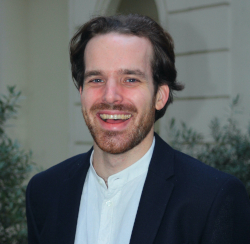 Evan Bonney is a PhD Candidate at The Sciences Po Centre for History. He is a 2023-2024 Research Fellow.
My time as fellow with the Consortium for the History of Science, Technology, and Medicine was indispensable for me to progress with my dissertation. Their generous financial and intellectual support helped guide me throughout the 2023-2024 academic year, and, without this fellowship, I am convinced that my project would have never taken shape the way that it has.
The Consortium offered me funding to visit various archives in the United States. With my project focusing on the development of forestry as a U.S. federal prerogative it was necessary for me to travel to four different special collections and archive collections to consult the papers of those who founded the discipline in the United States. Picking up research I had already conducted on the papers of Gifford Pinchot at the Library of Congress and the papers of Henry Solon Graves at Yale University, the funds provided by the Consortium allowed me to consult the papers of Charles Sprague Sargent at Harvard’s Arnold Arboretum as well as first editions ofGeorge Perkins Marsh’s Man and Nature held at the Linda Hall Library in St. Louis, Missouri. During these trips, I uncovered invaluable material that I have since incorporated into my chapters on forestry as a science, forests and water management, and on forests and grazing.
Of particular value were the letters that I found between Harvard Botanist Charles Sprague Sargent, the Inspector General of Forests for British India, Dietrich Brandis, and U.S. Army Engineer, Henry Abbott. Held at Harvard’s Arnold Arboretum, these exchanges revealed how education in law was primordial for training a forester at the turn of the twentieth century. They also revealed that Sargent, despite having been a professional mentor to Gifford Pinchot before Pinchot’s appointment as Chief of the USDA Division of Forestry in 1898, had professional falling-out with Pinchot due to his mistrust of Pinchot’s political connections. These sources have nuanced the analysis that I was in the process of conducting before I came across them, and they provide a more informed look into the politics of forestry as a science for administration at the turn of the twentieth century.
One final and critical archival sub-collection I found was in the Gifford Pinchot Papers at the Library of Congress. This held Pinchot’s annotated copies of a report on forests as sponges for water capture published by U.S. Army Corps Engineer Hiram Chittenden in 1908. Pinchot’s annotations show how attached he was to demonstrating that forests acted as sponges, and how they were able to absorb precipitation much better than unforested areas. Chittenden disagreed with this premise long dear to foresters as one of the primary justifications for their profession. In February of that year, Pinchot took the opportunity to demonstrate in a public hearing before the House Judiciary committee that Chittenden’s conclusions were false. Pouring a glass of water over a cellulose photograph, the water slicked off the photograph, compelling Pinchot to compare what was happening to what occurred in a denuded landscape; water just flowed straight off rather than being absorbed into the soil. Pinchot devised this while reading Chittenden’s report, adding other lambasting comments in the margins. This was not just an entertaining archive to find, but it revealed the vulnerability that forestry faced in federal administration. Even a decade after Pinchot’s leadership as Chief of the U.S. Forest Service, he still had to defend the professional merits of forestry from critics of other professions close to the state such as engineers.
Should I have never had the opportunity to consult these archives, my dissertation would never have taken its current form that concentrates heavily on the development of forestry as a profession. I can confidently say that the invaluable help of the Consortium has led me to presently feel that I will be able to make a contribution to the history of forestry in the United States in ways that both nuance and inform its historiography. Feeling this at this particular stage of the project is incredibly motivating, and I cannot thank the Consortium enough for fostering this throughout the 2023-2024 academic year.
Lastly, the intellectual community built by the weekly Consortium Fellows sessions was especially helpful. Participants always offered intellectually probing questions, and, particularly during my presentation, helped to me to reflect on some of the concepts my project engages with. This was crucial for me as I worked through a challenge with my analysis, and the comments led me to sharpen the definitions I employ. The other sessions I attended further provided a space for us to both challenge and encourage each other as colleagues in a lovely atmosphere that I myself would wish to cultivate should I ever lead a working group, seminar, or intellectual organization such as the Consortium later in my career.
The Consortium Fellowship therefore went above and beyond my expectations both in how it helped my project develop and how it shaped my own development as a young professional. I will look fondly on this year as Consortium Fellow and will think often too of the archivists and colleagues that it has connected me with along the way. For this, I feel truly indebted and thank the Consortium again for believing my project merited the support it provided me. |